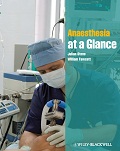You are called to assess a previously healthy 58-year-old male, 5 days following a bowel resection for diverticular disease, who is noted to have an Spo2 of 84% on room air. His postoperative course has been complicated by recurrent ileus, pyrexia and intermittent abdominal pain.
-
1. What are the hazards of untreated hypoxia?
Show Answer
Correct answer:
- reduced global oxygen delivery (CO × Hb × Spo2 × 1.34);
- end-organ ischaemia and dysfunction, particularly cerebral (CVA, confusion) cardiac (angina, MI, arrhythmias) and gut (anastomotic breakdown and bacterial translocation);
- wound ischaemia.
-
2. Describe your immediate management
Show Answer
Correct answer:
Take the history and examination of the patient. Send off arterial blood gas. Administer humidified oxygen and reassess oxygen saturations.
-
3. What other investigations may be useful?
Show Answer
Correct answer:
Arrange chest and abdominal X ray, ECG, blood cultures, full blood count and CRP.
-
4. The following statements represent different scenarios – a likely diagnosis and treatment is given in each case
-
(a) Two hours previously he received a large dose of morphine for pain and his respiratory rate had dropped to 6 breaths per min and his Paco2 was 8.5 kPa (normal 4-6 kPa) What equation relates Paco2 and PAo2?
Show Answer
Correct answer:
- Alveolar gas equation. Patient has respiratory depression: when the Paco2 is high on breathing room air the PAo2 (and hence Pao2) must be low, i.e. the lungs themselves are working normally.
- Give oxygen. (Naloxone may be used for severe repertory depression but it will reverse analgesia.)
-
(b) He has had a temperature and a productive cough for 3 days.
Show Answer
Correct answer:
- Respiratory tract infection.
- Treat with humidified oxygen, physiotherapy and antibiotics. Send sputum for culture.
-
(c) He had a sudden onset of chest pain 3 hours earlier. His ECG shows right heart strain.
Show Answer
-
(d) He had a right internal jugular central line inserted for TPN following a prolonged ileus. His chest X ray shows no lung markings in the right hemithorax.
Show Answer
Correct answer:
- Pneumothorax.
- He will require a chest drain.
-
(e) He has been unwell with abdominal pain, pyrexial and peripheral vasodilatation and with a blood pressure of 90/50 mmHg.
Show Answer
Correct answer:
- Possible anastomotic leak with sepsis.
- He will require imaging of lower bowel, full blood count, clotting, CRP and blood cultures, plus aggressive treatment with antibiotics, oxygen, i.v. fluids, urinary catheter, and possibly central line. Later, he will need laparotomy and may need ICU if his condition worsens (e.g. for inotropes).
-
(f) He vomited and choked on a large amount of bile-stained fluid.
Show Answer
Correct answer:
- Aspiration pneumonia.
- He will require an urgent chest X ray. His initial treatment is with humidified oxygen, physiotherapy and possibly antibiotics. He may require admission to ICU for respiratory support up to and including ventilation of the lungs.

